Visa Traveler
Exploring the world one country at a time

Japan Visa for Tourists in 2024: A Comprehensive Guide
Updated: March 26, 2024
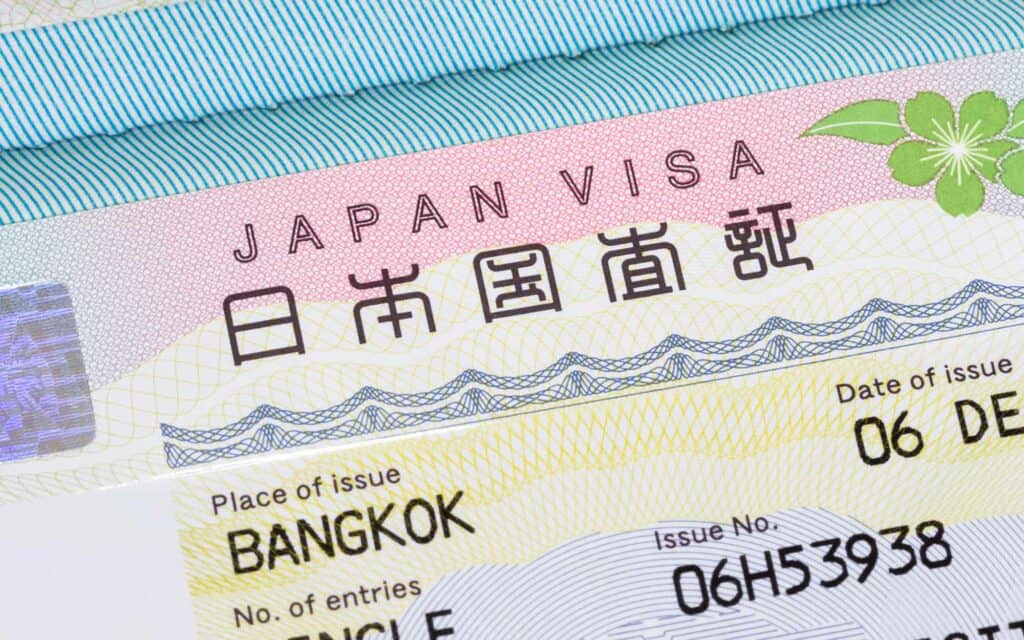
After being completely closed for tourism for more than 2 years, Japan finally reopened on October 11, 2022, restoring the previous visa exemptions and reducing the visa requirements.
Many nationalities are exempt from having to get a visa. Nationals and residents of select countries can obtain an eVisa online and everyone else can visit one of the over 200 embassies and consulates worldwide.
Table of Contents
Visa policy and visa types.
Nationals from 70 countries can travel to Japan visa-free . Most can stay up to 90 days.
Unless exempt, nationals and residents from 11 countries can apply for an eVisa online. They may still have to visit their nearest Japanese embassy. The eVisa allows stays for up to 90 days.
Everyone else must obtain a regular tourist visa from a Japanese overseas mission before traveling.
Japan does not have a visa on arrival.
Below is a summary of available visa types for tourists.
Entry Requirements
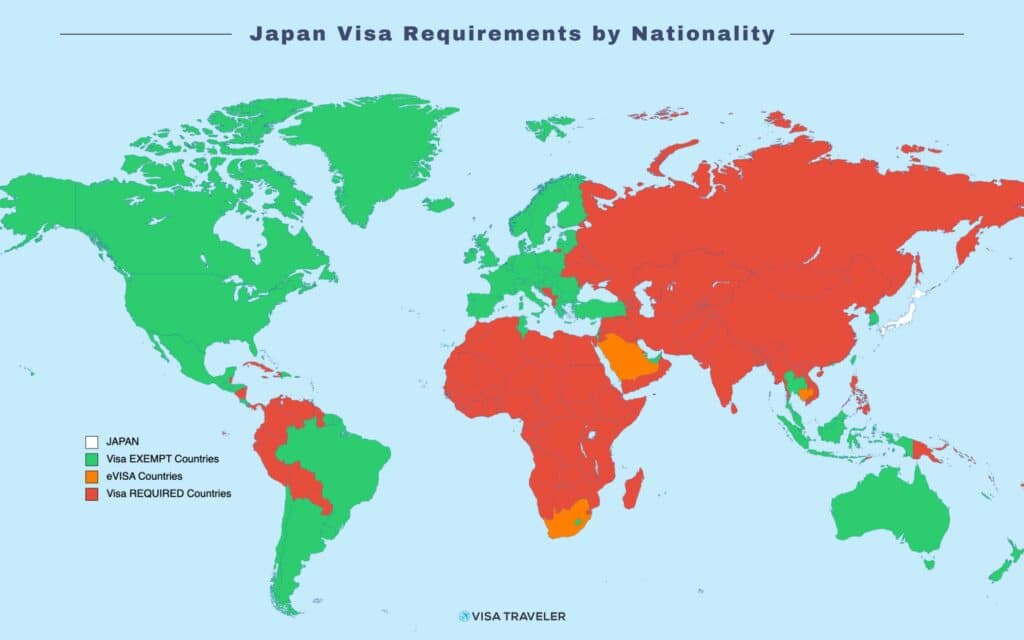
The following requirements apply to all visitors to Japan:
- Passport, which will remain valid during the period of stay
- Proof of sufficient funds to cover the cost of stay
- Return or onward ticket
Border officials rarely ask about the last 2.
For the specific visa requirements, see the corresponding section below.
Visa Exemption
Nationals of 70 countries are visa-exempted to travel to Japan. 65 countries are allowed to stay 90 days and the remaining 5 countries are allowed to say 14 to 30 days depending on the nationality.
There are additional requirements for some nationalities, outlined below. It’s best to check the official Japanese Foreign Ministry website for details.
- Austria (6)
- Barbados (5)
- Czech Republic
- Dominican Republic
- El Salvador
- Germany (6)
- Hong Kong (3)
- Ireland (6)
- Lesotho (5)
- Liechtenstein (6)
- Malaysia (2)
- Netherlands
- New Zealand
- North Macedonia
- South Korea
- Switzerland (6)
- United Kingdom (6)
- United States
- United Arab Emirates (2)
- Indonesia (1)
- Thailand (2)
- Must register an ePassport at a Japanese embassy in the respective country. Registration is valid for 3 years but not longer than the passport’s expiry date.
- Must have an ePassport, otherwise, need a visa.
- Only for passports issued by the corresponding Special Administrative Region.
- Must have a personal ID number.
- Must have a Machine-Readable Passport .
- Eligible to extend their stay to up to 6 months. Applications are made at a Regional Immigration Bureau inside Japan.
Japan eVisa
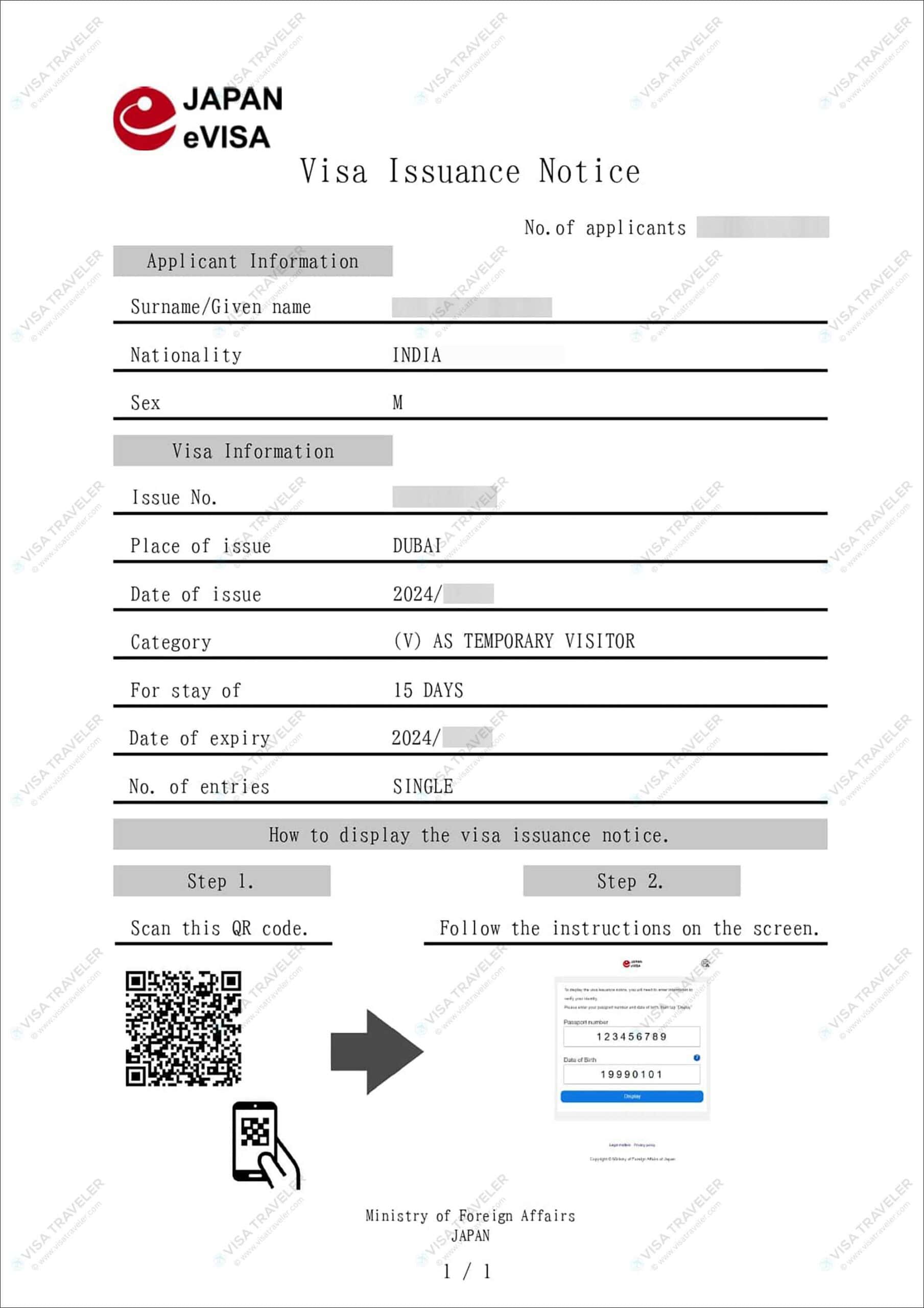
All nationals and residents from below 14 countries are eligible to apply for Japan eVisa. Those already visa-exempt don’t need to apply.
- Saudi Arabia
- South Africa
- United Arab Emirates
- United Kingdom
- Mongolia*
*Required to apply through an agency (see below).
Characteristics
- Only for tourism
- Valid for 3 months, single-entry only
- Duration of stay up to 90 days
- Fee 3,000 JPY or equivalent. Payable online or in person at the embassy. Some nationalities are exempt from the fee (check with your embassy)
- Processing takes 5 days to issue but could sometimes take longer
Documents required
What documents are required depends on your nationality and residence. These are the most commonly asked documents but check on the eVisa portal online for an exact list.
- Passport scan
- Color picture taken within the last 6 months
- Proof of immigration status (e.g. Permanent Residence Card or Visa if applicable )
- Flight itinerary (you don’t have to buy the tickets in advance, an itinerary from an airline is sufficient)
- Recent bank statement
- Travel itinerary (must be specific format, download eVisa travel itinerary template here)
- Proof of current residential address (e.g. driver’s license, state ID, utility bill, or lease agreement)
- Visa for the country you will visit after Japan (unless it’s your own country)
Application procedure
Applying online is incredibly simple. You can check out this video from Japan’s MOFA or follow the steps below.
- Go to Japan eVisa portal
- Register an account
- Fill out the application and upload the necessary documents
- Wait for your documents to be examined. You may be asked to submit additional documents. You will receive an email inviting you to pay when this step is complete.
- Pay online or in person
- After the eVisa has been issued, log in and make sure you can show the “ Visa Issuance Notice ” on your smartphone.
There’s no need to print any documents. On the contrary, you must show the visa on a digital device. Screenshots are not accepted either.
At the border, show the visa issuance notice with the QR code.
Once inside the country, you will receive an email saying your eVisa has expired. Don’t panic. This means you cannot use it to enter Japan again. You are allowed to stay up to 90 days inside Japan.
Applying from China, Vietnam, and Mongolia
Obtaining an eVisa for Japan in these three countries comes with special provisions.
EVisa is available to nationals of China who reside in China (excluding Hong Kong and Macau). You must apply through a Japan Visa Application Center or an accredited travel agency.
The eVisa grants entry to Japan for up to 30 days. Read more about it on the Japanese embassy in China website .
EVisa is available to nationals of Vietnam, who reside in Vietnam. You must book a packaged tour organized by a travel agency.
EVisa is available ONLY to foreign nationals who reside in Mongolia. You must apply at the Japan Visa Application Center (VAC) in Mongolia. Check with the Japanese embassy in Mongolia for more information.
Read the Japan eVisa article for more in-depth information on eVisa requirements, processing times, application process and border procedures.
Japan Tourist Visa
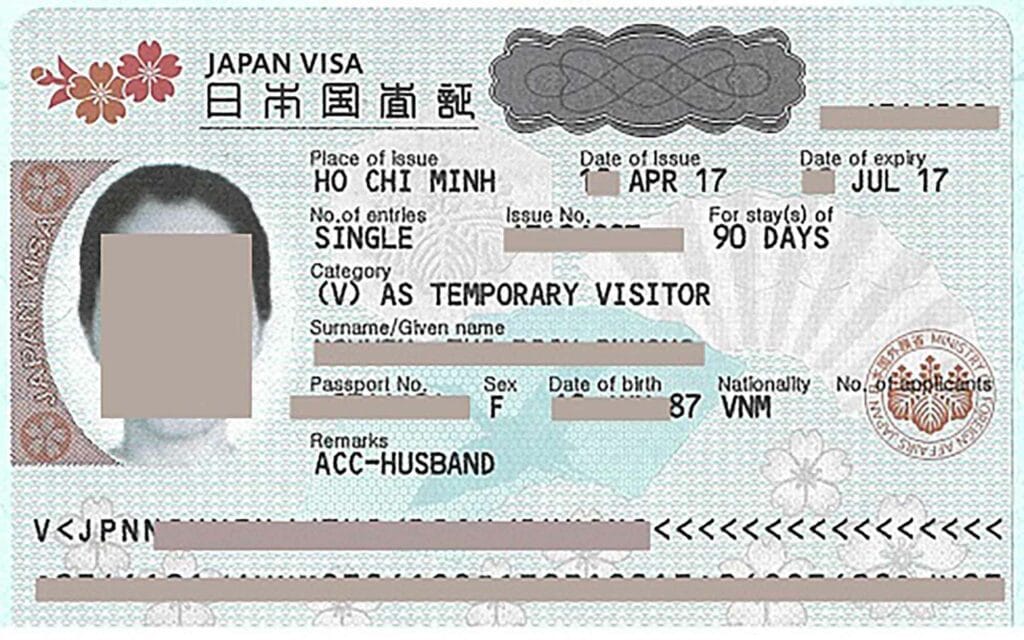
Everyone who’s not visa-exempt must obtain a visa to travel to Japan. If the eVisa isn’t an option, then you must obtain a tourist visa from a Japanese embassy.
Tourist visas are mostly single-entry. The term of stay can be either 15, 30 or 90 days from the date of entry. The visa itself is valid for 3 months for single entry and up to 5 years for multiple entry.
Requirements
The requirements for a tourist visa may differ depending on your nationality and the embassy you apply from. In most cases, they are:
- Passport with at least 2 blank pages
- Completed Visa Application Form
- 1 Passport-sized color photo taken within the last 6 months
- Flight itinerary
- Hotel reservation unless staying in an invitee’s home. It must cover the entire stay in Japan .
- Detailed, day-by-day itinerary in Japan .
- Most recent bank statement
- Proof of immigration status (if applicable)
The visa costs 3,000 JPY (~21$) or equivalent.
For further reading, check out the Japan Tourist Visa article for details such as when to apply, photo requirements and the application process.
Benefits of Japan tourist visa
Japan’s tourist visa is becoming a strong visa these days. That means Japanese visas have added benefits such as VISA-FREE travel to many other countries. As of 2024, you can travel to 14 countries with a Japanese visa. Read the VISA-FREE countries for Japan visa article for more details.
Transiting in Japan
Not leaving the airport.
If you are not already visa-exempt, you can transit in Japan without a visa only if:
- You stay within the international transit area of the airport;
- You have the necessary documents needed for the next country of destination;
- within 72 hours for Tokyo Haneda Airport or Kansai Airport (Osaka);
- within the same calendar day for all other airports.
Transit Visa
If you intend to pass through immigration and enter Japan for a short period, you must obtain a transit visa.
The requirements and procedures for obtaining transit visas are identical to regular tourist visas.
The main differences are in cost and duration of stay. The transit visa costs 700 JPY (~5$) and is issued for a maximum of 15 days but usually just 2-3 days until your next flight.
Japan Shore Pass
If you are transiting in Japan for less than 72 hours and you have a connecting flight that’s NOT on the same day, you may be able to obtain the Japan Shore Pass.
The application for it is usually done by the airline so it’s best to consult them.
To be eligible for the shore pass, you must arrive and depart from airports and seaports within the same group.
- Airports : Narita, Haneda, Nagoya, Niigata, Komatsu, Yokota.
- Seaports : Tokyo, Yokohama, Niigata, Nagoya.
- Airports : Osaka, Nagoya, Komatsu.
- Seaports : Osaka, Kobe, Nagoya.
- Airports : Fukuoka, Nagasaki, Kumamoto, Kagoshima, Naha, Kadena.
- Seaports : Hakata, Shimonoseki, Naha.
- Airports : Chitose.
- Seaports : Tomakomai, Otaru, Hakodate, Muroran.
Entry Procedure at the Airports
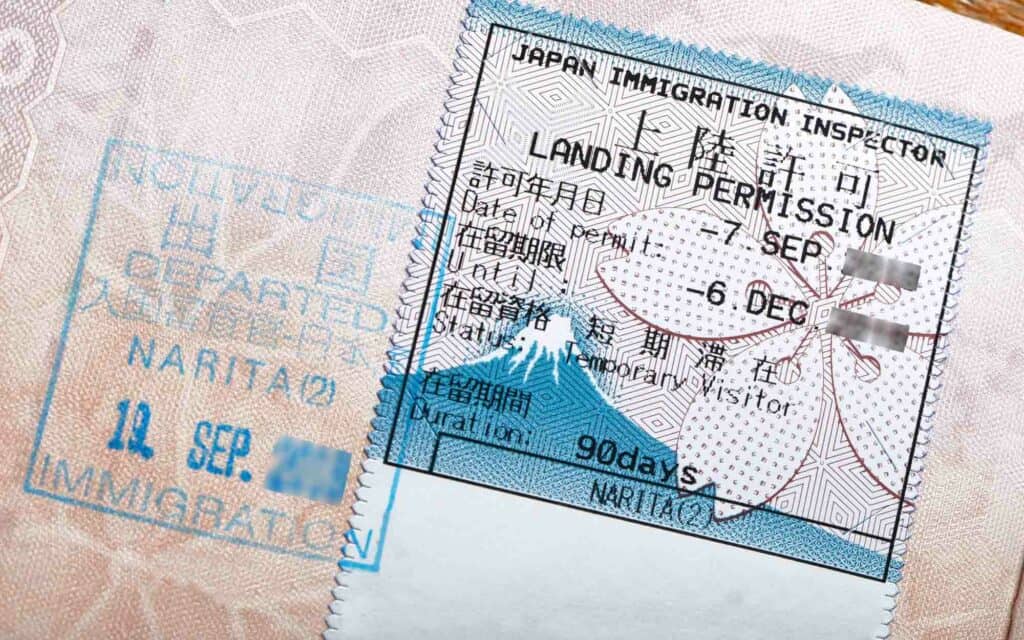
You may use the Visit Japan Web to submit all required information online. It’s not mandatory. Instead of paper forms, you will show QR codes.
After landing, you will sequentially go through immigration and customs.
If you got the eVisa, show your visa issuance notice on a smartphone. Otherwise, just your passport. Get a stamp and enjoy Japan.
Frequently Asked Questions (FAQs)
Is a covid vaccination certificate required to travel to japan.
COVID vaccination certificates and tests are not required since April 29, 2023.
Can I apply for a Japan visa online?
Yes but only if you’re a national or resident of the 11 eligible countries listed above.
How much does a Japan visa cost?
Japan visa costs 3000 YEN or equivalent in another currency.
How long does visa processing take?
Japan visa processing normally takes 5 working days but it could take more. It’s a good idea to apply for a visa at least a month before you travel.
Can I get a multiple-entry visa?
Japan eVisas are single-entry only. Embassies may issue multiple-entry visas depending on your circumstances.
WRITTEN BY THIRUMAL MOTATI

Thirumal Motati is an expert in tourist visa matters. He has been traveling the world on tourist visas for more than a decade. With his expertise, he has obtained several tourist visas, including the most strenuous ones such as the US, UK, Canada, and Schengen, some of which were granted multiple times. He has also set foot inside US consulates on numerous occasions. Mr. Motati has uncovered the secrets to successful visa applications. His guidance has enabled countless individuals to obtain their visas and fulfill their travel dreams. His statements have been mentioned in publications like Yahoo, BBC, The Hindu, and Travel Zoo.
PLAN YOUR TRAVEL WITH VISA TRAVELER
I highly recommend using these websites to plan your trip. I use these websites myself to apply for my visas, book my flights and hotels and purchase my travel insurance.
01. Apply for your visa
Get a verifiable flight itinerary for your visa application from DummyTicket247 . DummyTicket247 is a flight search engine to search and book flight itineraries for visas instantly. These flight itineraries are guaranteed to be valid for 2 weeks and work for all visa applications.
02. Book your fight
Find the cheapest flight tickets using Skyscanner . Skyscanner includes all budget airlines and you are guaranteed to find the cheapest flight to your destination.
03. Book your hotel
Book your hotel from Booking.com . Booking.com has pretty much every hotel, hostel and guesthouse from every destination.
04. Get your onward ticket
If traveling on a one-way ticket, use BestOnwardTicket to get proof of onward ticket for just $12, valid for 48 hours.
05. Purchase your insurance
Purchase travel medical insurance for your trip from SafetyWing . Insurance from SafetyWing covers COVID-19 and also comes with a visa letter which you can use for your visas.
Need more? Check out my travel resources page for the best websites to plan your trip.
LEGAL DISCLAIMER We are not affiliated with immigration, embassies or governments of any country. The content in this article is for educational and general informational purposes only, and shall not be understood or construed as, visa, immigration or legal advice. Your use of information provided in this article is solely at your own risk and you expressly agree not to rely upon any information contained in this article as a substitute for professional visa or immigration advice. Under no circumstance shall be held liable or responsible for any errors or omissions in this article or for any damage you may suffer in respect to any actions taken or not taken based on any or all of the information in this article. Please refer to our full disclaimer for further information.
AFFILIATE DISCLOSURE This post may contain affiliate links, which means we may receive a commission, at no extra cost to you, if you make a purchase through a link. Please refer to our full disclosure for further information.
MORE VISA GUIDES

UNITED KINGDOM

VIEW ALL VISA GUIDES
- Cookie Policy
- Copyright Notice
- Privacy Policy
- Terms of Use
- Flight Itinerary
- Hotel Reservation
- Travel Insurance
- Onward Ticket
- Testimonials

Search this site
Philpad » Visa » Japan Visa Schedule of Stay Sample (Daily Schedule Form)
Japan Visa Schedule of Stay Sample (Daily Schedule Form)
Estimated reading time: 4 minutes
Here’s our Japan Visa Schedule of Stay sample form you can download for free and use as a guide for your Japanese tourist visa application. It is also called Daily Schedule for Japan travel itinerary.
I recently shared the article “How I got My Japan Multiple Entry Visa in One Shot.” One of the important requirements to submit for a Japanese tourist visa application is the Schedule of Stay , often also referred to as the Daily Schedule .
In this post, I will share an example of this document with you. You can also download the sample form and use it as a guide in making your daily schedule for your trip to Japan.
Table of Contents:
What is a Schedule of Stay Form for a Japanese Tourist Visa?
The Schedule of Stay form is a document that provides your itinerary for your travel to Japan. It covers your daily schedule. The Embassy of Japan has given a uniform format that should be followed correctly. For successful visa approval, applicants for a Japanese tourist visa must follow this format.

Japan Visa Schedule of Stay Sample Form for Tokyo Travel:
The document below shows an example of our Japan Schedule of Stay for a 9-day travel itinerary to Tokyo. We also followed it as a guide for our everyday journey in Japan.
You can use it as a reference or as a guide in making your schedule of stay for Osaka as well. Just change the details for your Osaka travel plans.
You must make hotel reservations before submitting the Daily Schedule form to the agency or embassy. Read my tips below on making hotel reservations without a down payment.
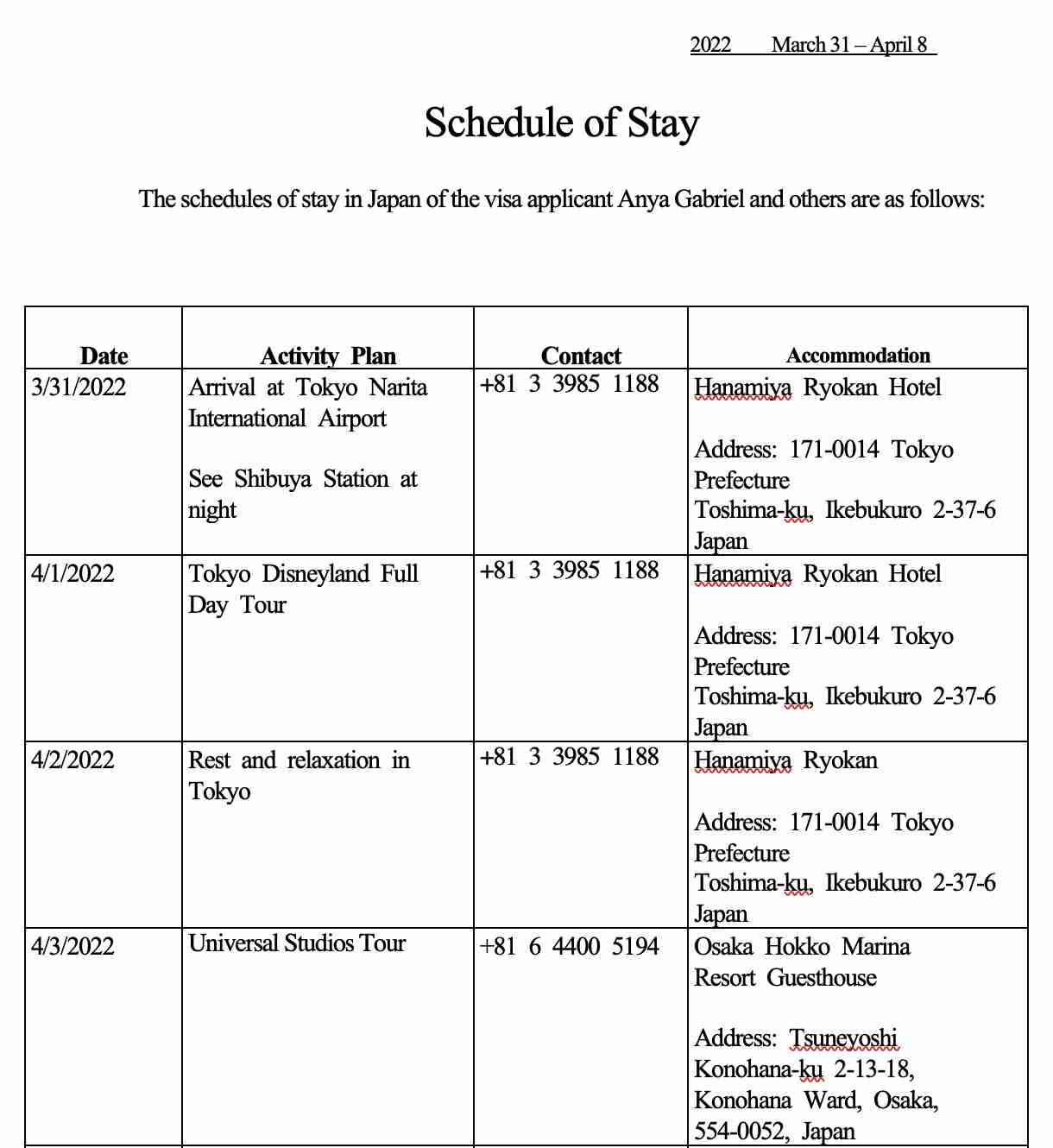
You can save the Japan Visa Schedule of Stay Sample Form in Word Format (.doc file) from this link: Schedule of Stay .
How to Submit a Daily Schedule Form for a Japanese Tourist Visa?
Step 1: create your travel itinerary to japan.
Start by deciding how many days you want to stay in Japan. Whether a 5-day stay in Tokyo or a 4-day stay in Osaka, you must indicate your daily tour plans throughout your vacation in Japan.
It helps that the areas you want to see are interconnected or closer to each other. It will make your itinerary more convincing and realistic.
Step 2: List down your travel activities per day
The format for the daily schedule includes the date of your tour and the related activities and tour events for the day. It’s better to list the tourist spots you plan to visit on the said date and mention the activities you plan to do, if any.
Step 3: Complete your accommodation details
Include your hotel accommodations with addresses and contact numbers. The list will guide your whole journey in Japan. Likewise, it will also add security and protection.
Make sure you provide accurate information, especially on the contact numbers of the hotels for your accommodation or the persons who are accommodating you for your stay in Japan.
Step 4: Print out your Daily Schedule
The Japanese visa Schedule of Stay form is one of the documents required when applying for a tourist visa in Japan. Print it out and attach it to your visa application.
The embassy might verify the information, so ensure you will only provide valid details and confirmed information on your document.
Step 5: Submit your Japanese tourist visa application
Submit your documents, including your Daily Schedule in Japan, when you apply for a Japanese tourist visa at the embassy of Japan at the country where you reside or at any travel agency accredited by Japan.
Do not worry about booking in advance for your hotel reservations. I will share with you the tips below on how to book hotels without paying.
How to Make a Hotel Reservation without Payment
I always use Booking.com for my hotel reservations because they allow reservations without any payment or credit card info.
You can also use it to book your hotels for your Schedule of Stay or your Japan travel. No worries, you can cancel the reservations without any fee, too.
I also find the cheapest hotels at Booking.com for my domestic and international travels.
Want to start applying for your Japan tourist visa? You can use our helpful references below to guide you and help you get approved.
Visa Application Related Articles:
- Japan Visa Cover Letter Sample
- Japan Travel Blog and Guide with Itinerary
How to Apply for Australian Tourist Visa in the Philippines
- How to Apply for UK Tourist Visa in the Philippines
Share this!
Related posts.
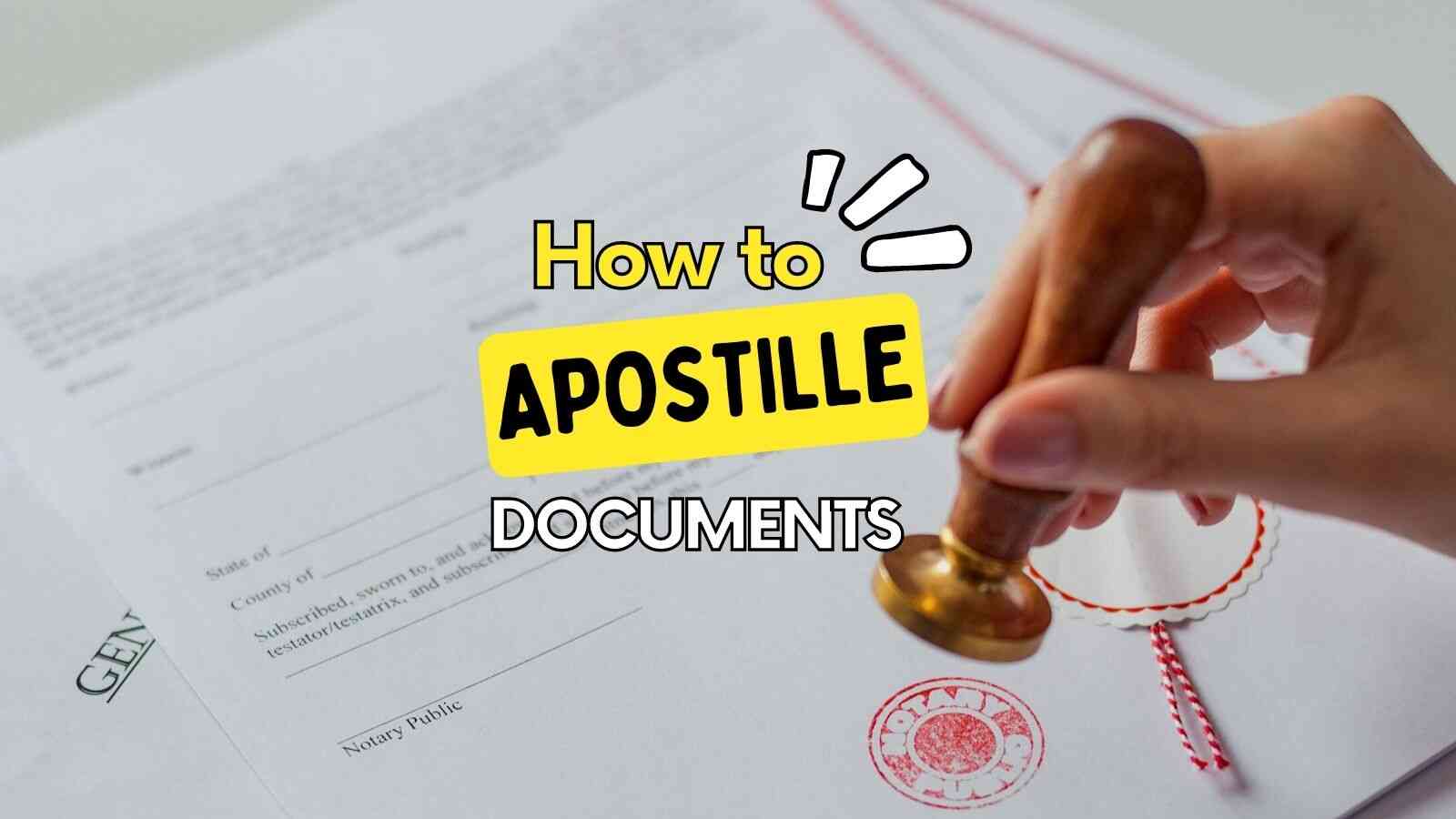
How to Apostille Documents in DFA Philippines (Birth Cert, TOR, NBI)

Australian Tourist Visa Requirements for Filipinos
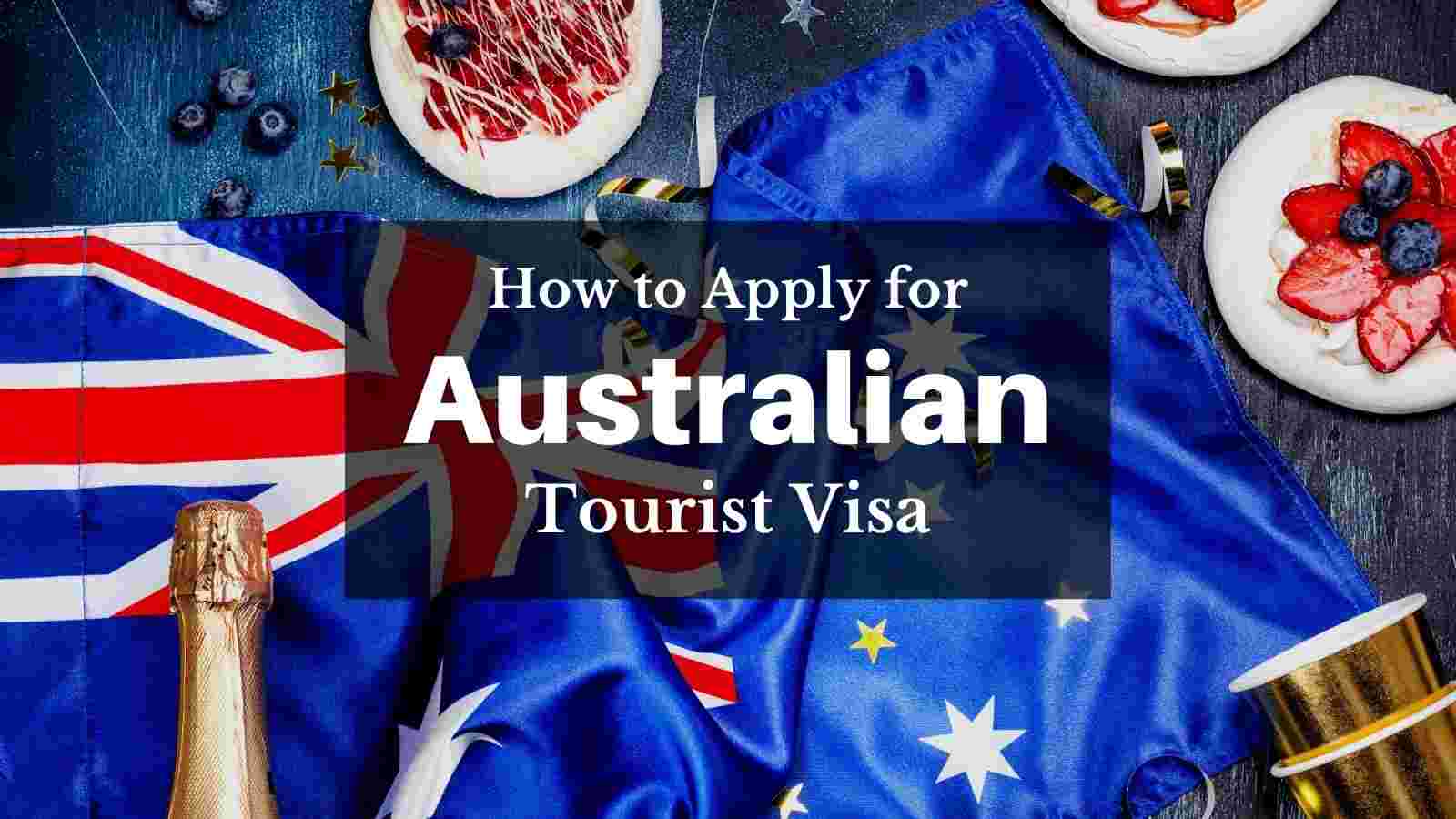
List of Accredited Travel Agencies for Korean Visa in the Philippines
Fehl is the founder of Philpad and has been writing online for 12 years. She has a bachelor's degree in Accountancy and a background in Finance. She is a licensed Career Service Professional and author of a poetry book at Barnes & Noble. In her spare time, she likes to travel and discover new places.
7 thoughts on “Japan Visa Schedule of Stay Sample (Daily Schedule Form)”
HI , did you submit one Itinerary only for the both of you ?Thank you
Hi 🙂 We submitted one itinerary per person.
Thank you so much 🙂
Hi just want to ask do they base amount on the bir 2316 cause I have no mark travels yet on my passport. Can u send me the complete requirements. Thanks much!
Doesn’t matter much as long as you have a regular job. Complete requirements are listed here: https://philpad.com/japan-tourist-visa-requirements-for-filipinos/
You don’t need to have bookings to fill in the Daily Schedule. I just got my multiple entry 30 day visa for 5 years to Japan without booking anything. No flight booking. No hotel/airbnb booking. I just checked the flight number to and from Tokyo and put it in the Visa Application Form. I also browsed cheap places to stay in the places I said I would go to and just used their address and contact info on the Daily Schedule. The embassy does not call the establishments to see if you are booked at that hotel. They just want to see if you are prepared enough to plan a trip. Even after I got my Visa, I haven’t booked anything yet. I plan to book flights when there is a sale and look for an airbnb once flights are booked. You don’t even have to stick to the places or things you put in the Daily Schedule.
I booked hotel reservations but I did not pay anything for those bookings. It is best to have confirmed reservations as it was advised by the Japanese agency where I lodged my application. It was also noted from their requirements. The embassy may or may not call those hotels to confirm per applicant but they may do it. Better to always follow the rules. 🙂
Leave a Comment Cancel reply
Notify me of follow-up comments by email.
Notify me of new posts by email.

We use cookies on this site to enhance your user experience. If you continue to browse you accept the use of cookies on our site. See our Cookie Policy for more information.
- Media & Industry
- Meetings & Events
- Select Language 简体中文 繁體中文(香港) 繁體中文(臺灣) India (English) Bahasa Indonesia 한국어 ภาษาไทย Tiếng Việt Singapore (English) Philippines (English) Malaysia (English) Australia/New Zealand (English) Français Deutsch Italiano Español United Kingdom (English) Nordic countries(English) Canada (English) Canada (Français) United States (English) Mexico (español) Português العربية Japan(日本語) Global (English)
- India (English)
- Bahasa Indonesia
- Singapore (English)
- Philippines (English)
- Malaysia (English)
- Australia/New Zealand (English)
- United Kingdom (English)
- Nordic countries(English)
- Canada (English)
- Canada (Français)
- United States (English)
- Mexico (español)
- Global (English)
- Fujiyoshida
- Shimonoseki
- Ishigaki Island
- Miyako Island
- Kerama Island
- Tokyo Island
- Koka & Shigaraki
- Hida Takayama
- Ginza, Nihonbashi
- Beppu & Yufuin (Onsen)
- Ginzan Onsen
- Nagasaki Islands

- Kumano Kodo
- Shikoku Karst
- Amami Oshima
- Hachimantai
- Omihachiman
- Aizuwakamatsu

- Diving in Japan
- Skiing in Japan
- Seasonal Flowers in Japan
- Sustainable Outdoors
- Off the Beaten Track in Japan
- Scenic Spots
- World Heritage
- Home Stays & Farm Stays

- Japanese Gardens
- Japanese Crafts
- Temple Stays
- Heritage Stays
- Festivals and Events
- Theater in Japan
- Japanese Tea Ceremony
- Cultural Experiences in Japan
- Culture in Japan

- Local Cuisine Eastern Japan
- Local Cuisine Western Japan
- Local Street Food
- Japan's Local Ekiben
- Japanese Whisky
- Vegetarian and Vegan Guide
- Sushi in Japan Guide
- Japanese Sake Breweries

- Art Museums
- Architecture
- Performing Arts
- Art Festivals
- Japanese Anime and Comics
- Japanese Ceramics
- Local Crafts

- Scenic Night Views
- Natural Wonders
- Theme Parks
- Samurai & Ninja
- Iconic Architecture

- Wellness Travel in Japan
- Japanese Ryokan Guide
- A Guide to Stargazing in Japan
- Relaxation in Japan
- Forest Bathing (Shinrin-yoku)

- Experiences in Japan
- Enjoy my Japan
- National Parks
- Japan's Local Treasures
- Japan Heritage
- Snow Like No Other
- Wonder Around Japan

- Visa Information
- Getting to Japan
- Airport Access
- COVID-19: Practical Information for Traveling to Japan
- Anime Tourism
- Countryside Stays
- Accessible Tourism
- Hokkaido Great Outdoors
- Scenic World Heritage in Tohoku
- Shikoku’s Nature and Traditions
- Southern Kyushu by Rail

- Traveling by Rail
- How to Travel by Train and Bus
- JR Rail Passes
- Scenic Railways
- Renting a Car
- Sustainable Travel in Japan
- Travel Brochures
- Useful Apps
- Online Reservation Sites
- Eco-friendly Accommodation
- Luxury Accommodations
- Traveling With a Disability
- Hands-free Travel
- How to Book a Certified Tour Guide
- Volunteer Guides
- Tourist Information Center

- Japanese Manners
- Spring in Japan
- Summer in Japan
- Autumn in Japan
- Winter in Japan
- Cherry Blossom Forecast
- Autumn Leaves Forecast

- Japan Visitor Hotline
- Travel Insurance in Japan
- Japan Safe Travel Information
- Accessibility in Japan
- Vegetarian Guide
- Muslim Travelers
- Safety Tips

My Favorites
${v.desc | trunc(25)}
Planning a Trip to Japan?
Share your travel photos with us by hashtagging your images with #visitjapanjp
- Visa Application
Travel Tips
AC Bonifacio in Japan
VIEW THIS IN FILIPINO

Top things to remember for first time travelers
Before you have an experience of a lifetime in your Japan trip, you just need to take care of the most important thing first, your Japan Tourist Visa! Below is a guide on how you can apply for your Japan Tourist Visa as well as fulfilling requirements for travelers to Japan.
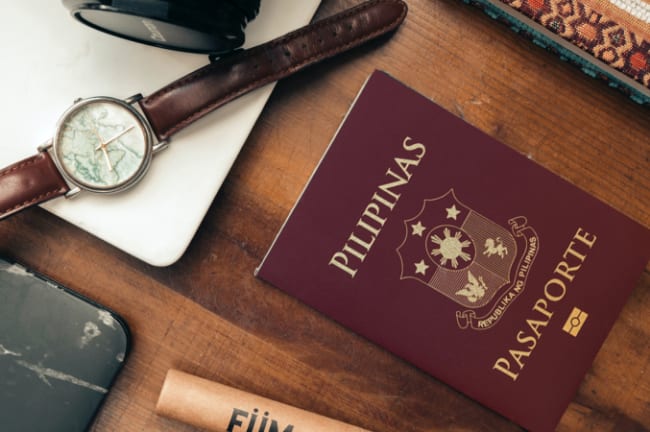
How to Apply for Japan Tourist Visa
Below is a step-by-step guide on how to apply for a Japanese Tourist Visa.
Note: The Japan National Tourism Organization (JNTO) cannot facilitate Visa applications nor can we answer Visa-related inquiries.
For Visa-related inquiries, kindly contact the Japanese Embassy in the Philippines. https://www.ph.emb-japan.go.jp/itpr_en/00_000035.html
- Passport (holder’s signature required)
- Visa Application form (one 4.5cm x 3.5 cm facial photo must be attached)
- Birth Certificate (issued by PSA within one year)
- Marriage Certificate (issued by PSA within one year, for married applicants only)
- Itinerary in Japan
Note: If there is a used Japanese Visa on your passport, birth certificate and marriage certificate are unnecessary.
If applicant will shoulder part/all travel expenses:
- Bank certificate
- Photocopy of Income Tax Return (BIR Form 2316)
If a guarantor will shoulder part/all travel expenses:
- Guarantee letter
- Proof of relationship between applicant and guarantor (e.g. birth certificates)
- Bank Certificate
You can get the application form from The Embassy of Japan in the Philippines website .
Make sure to make extra copies.
You can submit your application form with the required documents through these accredited travel agencies .
The Visa-handling fee for the Japan Tourist Visa varies per travel agency. You must pay the fee after you submit your documents.
The travel agency will contact you if your passport is ready for pickup.
Guides for Entry to Japan
Useful links.
Visit Japan Web
Visit Japan Web is a web service that people entering Japan can use to fast-track Immigration, and Customs procedures in order to enter/return to Japan.

COVID-19 Protocols
Learn everything you need to know about traveling to Japan with COVID-19 protocols.
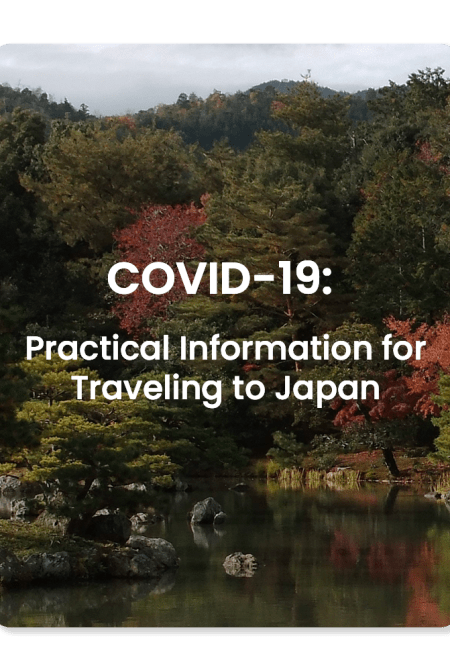
- Irasshaimase
Please Choose Your Language
Browse the JNTO site in one of multiple languages

TIPS: What you need to know about getting a Japan visa
Planning to travel to Japan any time soon?
Applying for a visa can be daunting, but it shouldn't stop you from taking that trip to see the Land of the Rising Sun. With some proper preparation of all the necessary documents, you'll be able to get approved for your Japan vacation.
There are different types of Japanese visas but we'll focus more on the tourist ones for those who want to go on a quick leisure trip to experience the country. There are two common tourist visas: the single-entry allowing holders to enter Japan once and stay for as long as 90 days, and the multiple entry visa which lets the holder enter the country many times within a specified period for at least 15 to 30 days each stay. Here are the requirements you'll need to get ready.
- Valid Philippine passport in good condition, must be signed and have at least two blank visa pages
- Visa application form which you can download here
- Your itinerary in Japan which includes your port of entry, where you intend to stay and the contact number of the accommodation
- A passport photo 2 x 1.4 inches with a white background taken within six months
- If your birth certificate is "late registration," you must also submit a Baptismal Certificate and a Form 137 from high school or elementary, both of which must be issued within at least three months
- You only need to submit a birth certificate if you have never applied for a Japan visa before
- You will also need to write a letter of authorization for the Japan Embassy to verify your birth certificate
- Original Marriage Certificate (if married) issued within one year
- Bank Certificate of a personal account (not company/business) issued within three months
- A copy of your latest Income Tax Return
If someone else will be shouldering your travel expenses, you must also submit the following:
- Guarantee letter
- Proof of relationship between applicant and guarantor
- Bank Certificate and Income Tax Return of the guarantor
Once you've acquired all the requirements, choose an accredited travel agency from this list from the Japanese Embassy. Fees may cost P950 to P1,200 for a single entry visa, depending on the travel agency.
Multiple-entry requirements
Want to get a multiple-entry visa? This type of visa has some conditions for issuance, so it may not be as easy to get one. For instance, you will need to have a history of travel as a temporary visitor to the country in the last three years.
If you pass the conditions, you will need the same requirements as above but also include an explanation letter for requesting multiple entry, proof of your travel to Japan in the last three years, and proof of financial capacity.
So how much money do you need in your bank account to get your visa approved? The Japanese Embassy hasn't really specified a certain amount but what's advised is to have enough to fund your travel expenses.
As for how long a tourist visa is processed, it will usually take seven to 10 business days. It's best to get your visa processed a month before your trip so you have ample time to request documents that you might not have around.
Additionally, you don't need to book a hotel or a flight before your visa is processed. In fact, travel agencies advise against it. It's best to book once your visa is approved.
Remember, just because you submitted all your documents, it doesn't automatically mean that you'll be granted the visa.
This article TIPS: What you need to know about getting a Japan visa was originally published in PhilSTAR L!fe
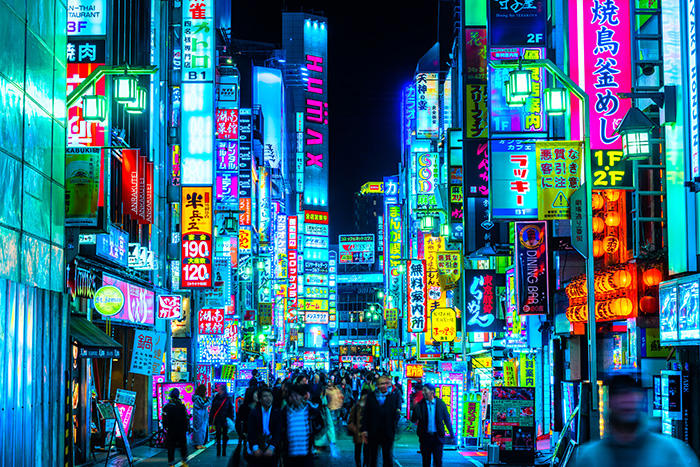
- Share full article

Stephen Hiltner/The New York Times
The sculpted facade of a 2,000-year-old tomb glows in the late-afternoon sun at Hegra, a UNESCO World Heritage site.
Crowds of Muslim pilgrims gather outside the Prophet’s Mosque in Medina.
Camels march through the desert on the outskirts of the Empty Quarter, the world’s largest sand sea.
For many years these Saudi Arabian scenes, including the lively open-air markets in Jeddah, were off limits to most travelers.
But not anymore. As it undergoes a profound transformation, Saudi Arabia is spending lavishly to lure tourists with its luxe new resorts ...
... its rich cultural heritage ...
... and its sublime natural beauty.
Can the Saudi government persuade would-be visitors to look past — or reconsider — its longstanding associations with religious extremism, ultraconservatism and human rights abuses?
Will the kingdom’s $800 billion bet on tourism pay off?
Supported by
Surprising, Unsettling, Surreal: Roaming Through Saudi Arabia
To witness the kingdom’s profound transformation and assess its ambitious tourism projects, a Times journalist spent a month on the road there. Here’s what he saw.

By Stephen Hiltner
An editor and photojournalist for the Travel section, Stephen Hiltner drove 5,200 miles and visited all 13 of Saudi Arabia’s provinces while reporting and shooting this story.
Wandering alone along the southern fringes of Saudi Arabia’s mountainous Asir Province, some eight miles from the Yemeni border, in a nondescript town with a prominent sculpture of a rifle balanced on an ornately painted plinth, I met a man, Nawab Khan, who was building a palace out of mud.
Actually, he was rebuilding the structure, restoring it. And when I came across him, he hadn’t yet begun his work for the day; he was seated on the side of the road beneath its red-and-white windows — cross-legged, on a rug, leaning over a pot of tea and a bowl of dates.
Two weeks earlier, on the far side of the country, a fellow traveler had pointed at a map and described the crumbling buildings here, in Dhahran al-Janub, arranged in a colorful open-air museum. Finding myself nearby, I’d detoured to have a look — and there was Mr. Khan, at first looking at me curiously and then waving me over to join him. Sensing my interest in the cluster of irregular towers, he stood up, produced a large key ring and began opening a series of padlocks. When he vanished through a doorway, I followed him into a shadowy stairwell.
This, of course, was my mother’s worst nightmare: Traveling solo, I’d been coaxed by a stranger into an unlit building in a remote Saudi village, within a volatile border area that the U.S. Department of State advises Americans to stay away from .
By now, though, more than halfway through a 5,200-mile road trip, I trusted Mr. Khan’s enthusiasm as a genuine expression of pride, not a ploy. All across Saudi Arabia, I’d seen countless projects being built, from simple museums to high-end resorts. These were the early fruits of an $800 billion investment in the travel sector, itself part of a much larger effort, Vision 2030 , to remake the kingdom and reduce its economic dependence on oil.
But I’d begun to see the building projects as something else, too: the striving of a country — long shrouded to most Westerners — to be seen, reconsidered, accepted. And with its doors suddenly flung open and the pandemic behind us, visitors like me were finally beginning to witness this new Saudi Arabia, much to Mr. Khan’s and all the other builders’ delight.

Few countries present as complicated a prospect for travelers as Saudi Arabia.
Long associated with Islamic extremism, human rights abuses and the oppression of women, the kingdom has made strides in recent years to refashion its society and its reputation abroad.
The infamous religious police, which upheld codes of conduct based on an ultraconservative interpretation of Islam, were stripped of their power. Public concerts, once banned, are now ubiquitous. Women have been granted new rights — including the freedom to drive and to travel without permission from a male guardian — and are no longer required to wear floor-length robes in public or to cover their hair.
These changes are part of a broad set of strategies to diversify the kingdom’s economy, elevate its status in the world and soften its image — the last of which is a tall order for a government that has killed a newspaper columnist , kidnapped and tortured dissidents , precipitated a humanitarian crisis in Yemen and imprisoned people for supporting gay rights , among a number of other recent abuses .
Central to the transformations led by 38-year-old Crown Prince Mohammed bin Salman, the kingdom’s de facto ruler, is a major push for international visitors. It represents a sea change in a country that, until 2019, issued no nonreligious tourist visas and instead catered almost exclusively to Muslim pilgrims visiting Mecca and Medina, Islam’s two holiest cities. In February, by contrast, my tourist e-visa was approved online in minutes.
Saudi Arabia has already transformed one of its premier destinations — Al-Ula, with its UNESCO-listed Nabatean tombs — from a neglected collection of archaeological sites into a lavish retreat with a bevy of activities on offer, including guided tours, wellness festivals, design exhibitions and hot air balloon rides.
Another project will create a vast array of luxury resorts on or near the Red Sea.
Still more projects include the development of Diriyah , the birthplace of the first Saudi state; the preservation and development of the coastal city of Jeddah ; an offshore theme park called the Rig ; and Neom , the futuristic city that has garnered the lion’s share of attention.
All told, the country is hoping to draw 70 million international tourists per year by 2030, with tourism contributing 10 percent of its gross domestic product. (In 2023, the country logged 27 million international tourists, according to government figures , with tourism contributing about 4 percent of G.D.P.)

At-Turaif, a UNESCO World Heritage site, was the birthplace of the kingdom of Saudi Arabia. It is now the centerpiece of the $63 billion Diriyah project, a new center of culture just outside Riyadh.
Nujuma, a Ritz-Carlton Reserve on a remote island in the Red Sea, opened in late May. (A one-bedroom villa costs about $2,500 per night, excluding taxes and fees.) It is one of 50 properties scheduled to open in the area by 2030.
The preservation and development of Jeddah, a coastal city famous for its historic district built largely from blocks of coral, comes with a price tag of some $20 billion.
Al-Ula is a cornerstone of Saudi Arabia’s tourism ambitions. Part of the city’s Old Town, long crumbling in neglect, has now been painstakingly restored.
To get a sense of these projects and the changes unfolding in Saudi society, I spent a month exploring the kingdom by car. I traveled alone, without a fixer, driver or translator. Per New York Times ethics guidelines, I declined the government’s many offers of discounts and complimentary services.
Much of the time I felt I’d been tossed the keys to the kingdom. But there were moments, too, when I faced a more complicated reality, one epitomized by a road sign that forced me to abruptly exit the highway some 15 miles from the center of Mecca. “Obligatory for Non Muslims,” it read, pointing to the offramp.
To me, the sign broadcast the lines being drawn to compartmentalize the country, which is now marketing itself to two sets of travelers with increasingly divergent — and sometimes contradictory — expectations: luxury tourists at ease with bikinis and cocktails, and pilgrims prepared for modesty and strict religious adherence. It’s hard to know whether the kingdom can satisfy both without antagonizing either.
My trip began in Jeddah, where, after spending two days exploring its historic district, I rented a car and drove eight hours north to Al-Ula, a benchmark for the new Saudi tourism initiatives.

Saudi Arabia
Reporter’s route
Dhahran al-Janub

Wadi al-Disah
Red Sea Resort
The name Al-Ula refers to both a small city and a broader region packed with attractions: Hegra , the kingdom’s first UNESCO World Heritage site and its biggest archaeological draw, is a 30-minute drive north of Old Town, a maze of crumbling mud-brick buildings now partly restored. Between the two, and fanning out to the east and west, are several other archaeological sites, as well as a smattering of resorts, event spaces and adventure outfitters. Farther northeast, beyond Hegra, is the Sharaan Nature Reserve , a vast protected zone used for conservation efforts.
My first priority during my five-day stay in Al-Ula was a visit to Hegra.
Like Petra , its better-known counterpart in Jordan, Hegra was built by the Nabateans, an ancient people who flourished 2,000 years ago. The site contains more than 100 tombs that were carved from solid rock, their entrances adorned with embellishments. Most impressive among them, set apart and standing some 70 feet tall, is a tomb colloquially called the Lonely Castle.
Not long ago, visitors could hire private guides and wander the area on foot, climbing in and out of — and no doubt damaging — the many tombs. Not anymore: I boarded an air-conditioned tour bus and zipped past most of them, stopping at just four locations.
At the penultimate stop, we exited the bus and trudged several hundred feet along a sandy path to the front of the Lonely Castle. Even in the late afternoon, the heat was stifling. I craned my neck to take in the details of the sculpted facade, which emerged like a mirage from one side of a massive boulder: its four pilasters, the rough chisel marks near the bottom, its characteristic five-stepped crown. Ten minutes evaporated, and I turned to find my group being shepherded back onto the bus. I jogged through the sand to catch up.
A few miles north of Hegra, I hopped in the back of a Toyota Land Cruiser — accompanied by an Italian graduate student and his mother — for a drive through the sandy expanse of the Sharaan Nature Reserve.
The scenery was sublime: Slipping through a narrow slot canyon, we emerged into a vast, open desert plain, then settled into a wide valley enclosed by an amphitheater of cliffs. Occasionally our guide stopped and led us on short hikes to petroglyphs, some pockmarked by bullet holes, or to lush fields of wildflowers, where he plucked edible greens and invited us to sample their lemony tang.
Gabriele Morelli, the graduate student, had first come to Al-Ula a few years ago — a different era, he said, given how quickly the place had transformed. He described a version that no longer exists, rife with cheap accommodation, lax rules and a free-for-all sensibility.
Some of the changes, of course, have been necessary to protect delicate ecosystems and archaeological sites from ever-growing crowds. But several people I met in Al-Ula — Saudis and foreigners alike — quietly lamented the extent of the high-end development and the steady erosion of affordability. Many of the new offerings, like the Banyan Tree resort, they pointed out, are luxury destinations that cater to wealthy travelers.
These hushed criticisms were among my early lessons on how difficult it can be to gauge the way Saudis feel about the pace and the pervasiveness of the transformations reshaping their society.
I got a taste of Al-Ula’s exclusivity — and of the uncanniness that occasionally surfaced throughout my trip — at a Lauryn Hill concert in an event space called Maraya . To reach the hall, I passed through a security gate, where an attendant scanned my e-ticket and directed me two miles up a winding road into the heart of the Ashar Valley, home to several high-end restaurants and resorts.
Rounding the final bend, I felt as if I’d stumbled into a computer-generated image: Ant-size humans were dwarfed by a reflective structure that both asserted itself and blended into the landscape. Inside, waiters served hors d’oeuvres and brightly colored mocktails to a chic young crowd.
The surreality peaked when, midway through the show, I left my plush seat to join some concertgoers near the stage — only to turn and see John Bolton, former President Donald J. Trump’s national security adviser, seated in the front row.
Where else, I wondered, could I attend a rap concert in the middle of the desert with a longtime fixture of the Republican Party — amid a crowd that cheered when Ms. Hill mentioned Palestine — but this strange new corner of Saudi Arabia?

The mirrored facade at Maraya, a vast event space in Al-Ula, warps and reflects the surrounding desert landscape.
The building is in some ways a precursor to the kingdom’s most ambitious architectural design: the project at Neom called the Line, a 106-mile linear city that will also feature a mirrored surface.
Lauryn Hill performing in front of a large crowd at Maraya.
After Al-Ula, I drove to another of the kingdom’s extravagant schemes: the Red Sea project, billed as the “world’s most ambitious regenerative tourism destination.” After weaving through a morass of construction-related traffic, I boarded a yacht — alongside a merry band of Saudi influencers — and was piloted some 15 miles to a remote island, where I disembarked in a world of unqualified opulence at the St. Regis Red Sea Resort .
I was chauffeured around in an electric golf cart — past 43 beachside “dune” villas and onto two long boardwalks that connect the rest of the resort to 47 “coral” villas, built on stilts over shallow turquoise water. Along the way, I listened to Lucas Julien-Vauzelle, an executive assistant manager, wax poetic about sustainability. “We take it to the next level,” he said, before rattling off a list of facts and figures: 100 percent renewable energy, a solar-powered 5G network , plans to enhance biologically diverse habitats.
By 2030, he said, the Red Sea project will offer 50 hotels across its island and inland sites. Citing the Maldives, he mentioned the kingdom’s plans to claim a share of the same high-end market.
Another prediction came by way of Keith Thornton, the director of restaurants, who said he expects the resort to legally serve alcohol by the end of the year. (While a liquor store for non-Muslim diplomats recently opened in Riyadh, the Saudi government has made no indication that it plans to reconsider its broader prohibition of alcohol.)
The hotel was undeniably impressive. But there’s an inescapable irony to a lavish resort built at unfathomable expense in the middle of the sea — with guests ferried out by chartered boat and seaplane — that flaunts its aspirations for sustainability.
Toward the end of my several-hour visit, I learned that every piece of vegetation, including 646 palm trees, had been transplanted from an off-site nursery. Later, reviewing historical satellite images, I found visual evidence that the island — described to me as pristine — had been dramatically fortified and, in the process, largely remade. Its footprint had also been significantly altered. It was, in a sense, an artificial island built where a smaller natural island once stood.
Something else struck me, too: The place was nearly empty, save for the staff and the Saudi influencers. Granted, the resort had just opened the month before — but the same was true at the nearby Six Senses Southern Dunes , an inland Red Sea resort that opened in November. Fredrik Blomqvist, the general manager there, told me that its isolated location in a serene expanse of desert — part of its appeal — also presented a challenge in drawing customers. “The biggest thing,” he said, “is to get the message out that the country is open.”
Since the country began issuing tourist visas, influencers have been documenting their experiences in places like Jeddah and Al-Ula, their trips often paid for by the Saudi government. Their breezy content contributes to the impression that the kingdom is awaiting discovery by foreign visitors with out-of-date prejudices. To an extent, for a certain segment of tourists, that’s true.
For many travelers, though, the depiction of the kingdom as an uncomplicated getaway could be dangerously misleading.
Speech in Saudi Arabia is strictly limited; dissent is not tolerated — nor is the open practice of any religion other than the government’s interpretation of Islam. In its travel advisory , the U.S. Department of State warns that “social media commentary — including past comments — which Saudi authorities may deem critical, offensive, or disruptive to public order, could lead to arrest.” Punishment for Saudi nationals has been far worse: In 2023, a retired teacher was sentenced to death after he criticized the ruling family via anonymous accounts. As of late 2023, he remained in prison.
Other restrictions are harder to parse. L.G.B.T.Q. travelers are officially welcome in the kingdom but face a conundrum: They might face arrest or other criminal penalties for openly expressing their sexual orientation or gender identity. As recently as 2021, an independent U.S. federal agency included Saudi Arabia on a list of countries where same-sex relationships are punishable by death , noting that “the government has not sought this penalty in recent years.”
When asked how he would convince a same-sex couple that it was safe to visit, Jerry Inzerillo, a native New Yorker and the group chief executive of Diriyah, said: “We don’t ask you any questions when you come into the country or when you leave.”
“Maybe that’s not conclusive enough,” he added, “but a lot of people have come.”
Female travelers might also face difficulties, since advancements in women’s rights are not equally distributed throughout the kingdom.
The changes were more visible in big cities and tourist centers. Ghydda Tariq, an assistant marketing manager in Al-Ula, described how new professional opportunities had emerged for her in recent years. Maysoon, a young woman I met in Jeddah, made extra money by occasionally driving for Uber. Haneen Alqadi, an employee at the St. Regis Red Sea, described how women there are free to wear bikinis without fear of repercussions.
Outside such places, though, I sometimes went for days without seeing more than a handful of women, invariably wearing niqabs, let alone seeing them engaged in public life or tourism. My photographs reflect that imbalance.
As an easily identifiable Western man, I moved through the country with an array of advantages: the kindness and cheery curiosity of strangers, the ease of passage at military checkpoints, and the freedom to interact with a male-dominated society at markets, museums, parks, restaurants, cafes. Not all travelers could expect the same treatment.
Roaming in the far north and south, I often found the earlier version of the kingdom — with lax rules and less development — that had been described to me in Al-Ula.
I trekked to the northern city of Sakaka to see an archaeological site promoted as the Stonehenge of Saudi Arabia: a set of monoliths called the Rajajil Columns thought to have been erected some 6,000 years ago but about which little is definitively known.
My heart sank when I pulled into the parking lot after a five-hour drive and found the columns blocked by a tall fence. Approaching on foot, though, I noticed that a section of the fence had been peeled back and that visitors were wandering freely among the stones, which protruded from the earth like isolated clusters of crooked teeth. I joined the small crowd, if hesitatingly, and was surprised to find no footpaths, nor anything to keep us a safe distance from the columns. In the end I wondered if our access had been officially approved or informally arranged.
My travel experiences were sometimes awkward in other ways, too.
Standing just outside the grounds of the central mosque in Medina, where the Prophet Muhammad is buried, I was detained by a stern member of the Special Forces. (Even after 2019, non-Muslim tourists remained barred from Mecca and Medina, Islam’s two holiest cities. The ban was relaxed in parts of Medina in 2021.)
The guard interrogated me and, after calling a colleague to confer, demanded that I leave the area. “Go,” he said threateningly. Another traveler who witnessed the encounter scurried away to avoid a similar fate.
The unsettling exchange cast a pall over my time in the city, which few non-Muslims have seen. As far as I knew, I’d abided by the rules by staying outside the grounds of the Prophet’s Mosque — a boundary line that I’d confirmed with tourism officials beforehand.

Peering through the perimeter fence — the boundary line for non-Muslims — at the Prophet’s Mosque in Medina.
The Mosque of Al-Ghamamah, one of the oldest in the holy city.
A sprawling maze of ramshackle residential buildings sits less than a mile from the Prophet’s Mosque.
A guide speaking to a group of visitors near the Hejaz Railway Museum, visible in the distance. (The museum was closed for renovations at the time.)
A group of young men, most of whose families emigrated from Sudan, playing soccer in a field just outside the center of Medina.
More than anything, family and friends wanted to know if I felt safe on my trip — and I did, almost without exception. Petty crime in Saudi Arabia is exceedingly rare. And while parts of the country are under a Level 4 “Do Not Travel” advisory , even my rambling itinerary was approved by a security expert.
Instead of fearing for my safety, I was often preoccupied with how I’d fairly portray a place that elicited such a range of conflicting emotions: joy and distress, excitement and apprehension, sincerity and doubt. So much lay hidden from public view — like the collective anguish over the war raging in Gaza . And so little was easy to categorize, in part because the warmth of everyday Saudis was strikingly at odds with the ruthlessness of their authoritarian government.
In Riyadh, a young man warned me not to speak openly with strangers. “People get arrested here for a tweet ,” he said. “Can you imagine?”
I could, actually. The Saudi columnist Jamal Khashoggi had chronicled his government’s increasingly draconian responses to criticism. “Repression and intimidation are not — and never should be — the acceptable companions of reform,” he wrote in The Washington Post in 2018, just months before he was killed and dismembered at his country’s consulate in Istanbul.

Were we to travel only where we feel comfortable and unchallenged, we’d all be poorer for it. But the question of whether to travel to Saudi Arabia is thornier than that.
It’s easy to see one response, “No,” as yielding to closed-mindedness at the expense of ordinary people — like the kindly vendor Abdullah, who served me local honey at his shop in the southern mountains.
But it’s easy, too, to see “Yes” as an affirmation that might makes right, that amusement outweighs morality, that princely wealth can wipe a stained slate clean.

Sunrise over the mountainous village of Fayfa, some six miles from the Yemeni border.
Abdullah Ghaleb Zaid, a honey vendor, at his shop atop a mountain pass near the southern city of Abha.
Sunset near Jabal Soudah, the kingdom’s highest peak.
Ten days into my trip, I ventured to Wadi al-Disah, a steep-walled valley where I’d booked a tent at a campsite I found on Airbnb. For an additional 300 riyals ($80), my host, Faisal, led me on a four-wheel-drive tour, departing the paved road and weaving through a path along the bed of an ephemeral river. Continually jolted by the uneven terrain, we eased past thick reeds, lofty palms and small bands of visitors who’d nestled into clearings.
As we left, I met a group of young men gathered for a picnic, their sandals scattered around a carpet on which they were preparing their dinner. Delighted to meet an American with a camera, they asked if I’d take a group portrait, then exchanged information with me so I could send them a copy — a scenario by then so familiar that I hardly thought anything of it.
A full day later, some 200 miles away, I was cruising along a lonely highway near the Jordanian border when a Land Cruiser blew past me at an astonishing speed. I felt my compact car rock from its turbulence — and then I watched with a twinge of dread as the car abruptly braked, slowing hard in the left lane until our front ends were aligned. It held steady there.
For a moment I stared straight ahead, hoping to avoid a confrontation. When I finally turned to look, I saw a group of boys grinning wildly and waving through an open window. Then I realized: Improbably, it was three of the young men I’d met the day before. Somehow we’d all followed the same route. And somehow, in the split second it took them to fly past, they’d recognized me. I lifted my camera from the passenger seat and snapped a photograph.
The picture shows three young Saudis on a precipice: endearing, erratic, captivating. I have a sense of where they came from but no certainty about where they’re going. Two are flashing peace signs, and none appears to be wearing a seatbelt. No one is watching the road as their car drifts out of its lane, careening a little recklessly into a hopeful and uncertain future.
Stephen Hiltner’s recent work includes a photo essay about his childhood in Budapest , an examination of A.I.-generated guidebooks and an investigation into the deaths of Russian soldiers in Ukraine . You can follow his travels on Instagram .
Got a question about this story? Drop a note in the comments section. Got a tip? Send him an email .
Stephen Hiltner is an editor, writer and photographer for the Travel section of The Times. More about Stephen Hiltner
Open Up Your World
Considering a trip, or just some armchair traveling here are some ideas..
52 Places: Why do we travel? For food, culture, adventure, natural beauty? Our 2024 list has all those elements, and more .
The Alaska Highway: On an epic road trip, a family plots a course from Alaska to the Lower 48, passing through some of Canada’s most spectacular scenery .
Minorca: Spend 36 hours on this slow-paced Spanish island , which offers a quieter and wilder retreat than its more touristy neighbors.
Japan: A new high-speed train stop unlocks Kaga, a destination for hot springs, nourishing food and traditional crafts , as an easy-to-reach getaway from Tokyo.
London: The Victoria and Albert Museum is a treasure trove of art and design. Here’s one besotted visitor’s plan for taking it all in .
Advertisement
The Federal Register
The daily journal of the united states government, request access.
Due to aggressive automated scraping of FederalRegister.gov and eCFR.gov, programmatic access to these sites is limited to access to our extensive developer APIs.
If you are human user receiving this message, we can add your IP address to a set of IPs that can access FederalRegister.gov & eCFR.gov; complete the CAPTCHA (bot test) below and click "Request Access". This process will be necessary for each IP address you wish to access the site from, requests are valid for approximately one quarter (three months) after which the process may need to be repeated.
An official website of the United States government.
If you want to request a wider IP range, first request access for your current IP, and then use the "Site Feedback" button found in the lower left-hand side to make the request.
The Ministry of Foreign Affairs website uses JavaScript. Please turn on "JavaScript" and use it.

Multiple Entry Visa (for nationals of visa exemption countries/regions)
Currently, all foreign nationals who wish to newly enter Japan need to apply for a visa except for re-entry cases. Meanwhile, the visa exemption measures for passport holders of countries/regions eligible to visa exemption will be resumed from 0:00 am (JST) on October 11, 2022.
[For entrants until October 10, 2022]
Currently, all foreign nationals are required to obtain a visa before entering the country except for those with re-entry permit. Nationals of visa exemption countries/regions that are currently under temporary suspension will be able to apply for a multiple-entry short-term stay visa for the purposes of business affairs, etc (Note) and for the spouse or child of a Japanese national from September 7.
Target group
- Nationals of visa exemption countries/regions
Types of Visa
Multiple entry short-term stay visa with validity of 1 year and maximum stay of 90 days at a time (business affairs, etc., spouse or child of a Japanese national)
(Note) In some cases, single-entry visa may be issued after examination.
Documents required for application
Business, etc..
- (1) Visa application form
- (2) Passport
- (3) Photograph
- (4) Certificate issued by the ERFS (the one with "Your intention of applying for Multiple Entry Visa" item marked "desired")
Spouse or child of a Japanese national
- (4) Documents certifying that the applicant is a spouse or child of a Japanese national

IMAGES
VIDEO
COMMENTS
How to Fill Out Japan Visa Application Form. First, a few important reminders. Complete the form either by hand or electronically. Either is accepted. If you go the hand-written route, make sure that you write in block letters and that they are readable. In fields that don't apply to you, write NA. Don't leave any field blank.
Inquiries about Visas Application. Foreign Residents Support Center (FRESC) MOFA Visa Information. Yotsuya Tower 13F, 1-6-1 Yotsuya, Shinjuku-ku, Tokyo, 160-0004 Navi-Dial: 0570-011000. (For some IP phones and calls from overseas, please call +81-3-5369-6577) Monday to Friday, 09:00-17:00.
Address 1-1 Abc-cho, Shinjuku-ku, Tokyo 160-XXXX. Dates and duration of previous stays in Japan From February 4 to April 3 in 2016; 2 months. Your current residential address (if you have more than one address, please list them all) Address 321 East Maple Street, New York, NY 10171, USA. Tel. 212-333-1111.
"I hereby consent to the provision of my personal information (by an accredited travel agent, within its capacity of representing my visa application) to the Japanese embassy/consulate-general and (entrust the agent with) the payment of my visa fee to the Japanese embassy/consulate-general, when such payment is necessary." (Day)/(Month)/(Year)
VISA APPLICATION FORM TO ENTER JAPAN . Date of birth Place of birth Sex: Male. Female Single. Married . Widowed . Divorced ... "I hereby consent to the provision of my personal information (by an accredited travel agent, within its capacity of representing my visa application) to the Japanese embassy/consulate-general and (entrust the agent ...
How to Make an Itinerary for Japan Visa Application. Date. This is the date when you make the itinerary. The standard format is YEAR/MONTH/DAY. Name. Don't forget to write your full name. Travel Dates. Pretty straight-forward. Activity Plan.
Applying for Japan tourist visa at the embassy is usually a 5 step process. Step 1: Gather all the necessary documents. Step 2: Apply in person at the Japanese embassy. Step 3: Remain available to reach - the embassy may request additional documents or an in-person interview.
April 26, 2024. Japanese. Tweet. Foreign nationals/people who wish to travel to Japan for tourism for a short-term period can apply for a visa online and receive an electronic visa (eVISA) through the JAPAN eVISA system. As of April 26, 2024, the JAPAN eVISA system is available for nationals/people residing in the following countries/regions.
"I hereby consent to the provision of my personal information (by an accredited travel agent, within its capacity of representing my visa application) to the Japanese embassy/consulate-general and (entrust the agent with) the payment of my visa fee to the Japanese embassy/consulate-general, when such payment is necessary." (Day)/(Month)/(Year)
The travel itinerary of the visa applicant(s) is as follows: Date Activity Plan Contact Accommodation Sep 2, 2022 Arrive at Haneda Airport (JAL005) +81-3-1111-22XX ABC Hotel 1-1 Abc-cho, Shinjuku-ku, Tokyo Sep 3, 2022 Go sightseeing in Asakusa Same as above Same as above ... SAMPLE . Title: Travel Itinerary Sample Created Date:
Along with the required documents for Japan visa applications, you also need pictures which follow these specifications: Dimensions: 4.5cm x 4.5cm. White background. Taken in the last six months. You must be staring straight ahead, with a neutral facial expression. Your entire face has to be visible.
VISA APPLICATION FORM TO ENTER JAPAN *Officialuse only (Pastephoto here) 45mmx45mm or 2inX2in. ... "I hereby consent to the provision of my personal information (by an accredited travel agent, within its capacity of representingmy visa application) to the Japanese embassy/consulate-general and (entrust the agent with) the payment of my visa ...
Any foreign visitor entering Japan must have a valid passport for the duration of their stay, and all visitors must comply with the conditions of their visas. See below for information about the current visa requirements for Japan. Visa Information. If you have any further questions, please contact the Japanese embassy or consulate in your ...
JAPAN VISA APPLICATION FORM: Sample + How to Fill it Out; JAPAN VISA: LIST OF TRAVEL AGENCIES Accredited by the Embassy; SAMPLE ITINERARY for JAPAN VISA Application (Schedule of Stay) IMPORTANT JAPAN VISA UPDATE: Additional NCOV/COVID-19 Form to be Submitted; Avoid These 12 COMMON MISTAKES when Applying for a JAPAN VISA!
Q1: I want to postpone my travel. Until when is my visa valid? A1: The period of validity of a single-entry visa (that becomes invalid as soon as once you enter Japan) is basically three months. Enter Japan within three months of the issuance of the visa. If you wish to postpone your travel for longer than three months, you will be required to make another visa application.
Updated: March 26, 2024. After being completely closed for tourism for more than 2 years, Japan finally reopened on October 11, 2022, restoring the previous visa exemptions and reducing the visa requirements. Many nationalities are exempt from having to get a visa. Nationals and residents of select countries can obtain an eVisa online and ...
The agencies assess the documents one by one to make sure that everything is in order. But sometimes, there are things that applicants fail to notice, throwing a wrench into an otherwise smooth process. Here are some of the common mistakes that Japanese visa applicants make. 1. Forgetting to sign the passport.
Step 4: Print out your Daily Schedule. The Japanese visa Schedule of Stay form is one of the documents required when applying for a tourist visa in Japan. Print it out and attach it to your visa application. The embassy might verify the information, so ensure you will only provide valid details and confirmed information on your document.
Step 1. Prepare the following documents. Passport (holder's signature required) Visa Application form (one 4.5cm x 3.5 cm facial photo must be attached) Birth Certificate (issued by PSA within one year) Marriage Certificate (issued by PSA within one year, for married applicants only) Itinerary in Japan. Note: If there is a used Japanese Visa ...
(The name must be written in the Latin alphabet as it appears on his/her passport. When there are two or more applicants, fill in the representative's status below, and attach a list of all applicants.)
There are two common tourist visas: the single-entry allowing holders to enter Japan once and stay for as long as 90 days, and the multiple entry visa which lets the holder enter the country many ...
Japan: A new high-speed train stop unlocks Kaga, a destination for hot springs, nourishing food and traditional crafts, as an easy-to-reach getaway from Tokyo. London: The Victoria and Albert ...
JAPAN VISA APPLICATION FORM: Sample + How to Fill it Out; JAPAN VISA FOR VISITING FRIENDS OR RELATIVES: Requirements & Steps; JAPAN VISA: LIST OF TRAVEL AGENCIES Accredited by the Embassy; SAMPLE ITINERARY for JAPAN VISA Application (Schedule of Stay) IMPORTANT JAPAN VISA UPDATE: Additional NCOV/COVID-19 Form to be Submitted
List of Visa Applicants * Be sure to write the name in the Latin alphabet as it appears on his/her passport. * Fill out the "relationship with the inviting person and guarantor" field if the purpose of the invitation is "Visit to relatives/acquaintances." 1. Visa applicant (representative applicant) Nationality: Occupation:
The fee for H-1B and L-1 petitions under Public Law 114-113 is $4,000 and $4,500, respectively. DHS does not have enough information on the number of times a petitioning employer would pay the 9-11 Biometric Fee due to the rule change to determine whether this rule has a significant impact on small businesses.
Currently, all foreign nationals who wish to newly enter Japan need to apply for a visa except for re-entry cases. Meanwhile, the visa exemption measures for passport holders of countries/regions eligible to visa exemption will be resumed from 0:00 am (JST) on October 11, 2022. [For entrants until October 10, 2022]